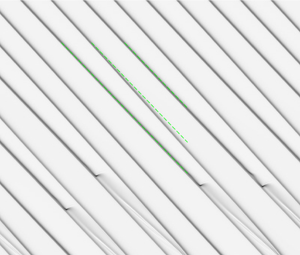Article contents
Superconfined falling liquid films: linear versus nonlinear dynamics
Published online by Cambridge University Press: 25 May 2021
Abstract

The effect of a counter-current gas flow on the linear stability of an inclined falling liquid film switches from destabilizing to stabilizing, as the flow confinement is increased. We confront this linear effect with the response of nonlinear surface waves resulting from long-wave interfacial instability. For the strongest confinement studied, the gas flow damps both the linear growth rate and the amplitude of nonlinear travelling waves, and this holds for waves of the most-amplified frequency and for low-frequency solitary waves. In the latter case, waves are shaped into elongated humps with a flat top that resist secondary instabilities. For intermediate confinement, the linear and nonlinear responses are opposed and can be non-monotonic. The linear growth rate of the most-amplified waves first decreases and then increases as the gas velocity is increased, whereas their nonlinear amplitude is first amplified and then damped. Conversely, solitary waves are amplified linearly but damped nonlinearly. For the weakest confinement, solitary waves are prone to two secondary instability modes that are not observed in unconfined falling films. The first involves waves of diminishing amplitude slipstreaming towards their growing leading neighbours. The second causes wave splitting events that lead to a train of smaller, shorter waves.
Information
- Type
- JFM Rapids
- Information
- Copyright
- © The Author(s), 2021. Published by Cambridge University Press
References
REFERENCES
Lavalle et al. Supplementary Movie 1
Open-domain computation with coherent inlet forcing at the linearly most-amplified frequency f=fmax. Parameters correspond to one of the periodically-stable travelling-wave solutions in panel 2c : eta=3 (curve with cross), Reg=-80, fmax=0.31. The gas-sheared wave train is subject to the well-known subharmonic instability of Liu and Gollub (Phys. Rev. Lett., vol. 70(15), 1993, pp. 2289-2292), leading to coalescence events and more dangerous large-amplitude waves.
Lavalle et al. Supplementary Movie 2
Open-domain computation reproducing the flat-top wave in panel 4d with coherent inlet forcing at frequency f=0.042. Only weak modulations occur in the region of the precursory capillary ripples.
- 11
- Cited by


